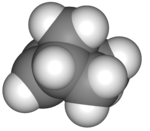Norbornene
|
|
|||
 |
|||
| Names | |||
|---|---|---|---|
|
Preferred IUPAC name
Bicyclo[2.2.1]hept-2-ene
|
|||
| Other names
Norbornylene
Norcamphene |
|||
| Identifiers | |||
|
498-66-8 |
|||
| 3D model (Jmol) | Interactive image | ||
| ChemSpider |
9925 |
||
| ECHA InfoCard | 100.007.152 | ||
| EC Number | 207-866-0 | ||
| PubChem | 10352 | ||
|
|||
|
|||
| Properties | |||
| C7H10 | |||
| Molar mass | 94.16 g·mol−1 | ||
| Appearance | White solid | ||
| Melting point | 42 to 46 °C (108 to 115 °F; 315 to 319 K) | ||
| Boiling point | 96 °C (205 °F; 369 K) | ||
| Hazards | |||
| NFPA 704 | |||
| Flash point | −15 °C (5 °F; 258 K) | ||
|
Except where otherwise noted, data are given for materials in their standard state (at 25 °C [77 °F], 100 kPa).
|
|||
|
|
|||
| Infobox references | |||
Norbornene or norbornylene or norcamphene is a bridged cyclic hydrocarbon. It is a white solid with a pungent sour odor. The molecule consists of a cyclohexene ring with a methylene bridge between C-3 and C-6. The molecule carries a double bond which induces significant ring strain and significant reactivity.
Norbornene, like many of its derivatives, is made by a Diels-Alder reaction of cyclopentadiene and ethylene. Related bicyclics are norbornadiene which has the same carbon skeleton but with two double bonds and norbornane which is completely saturated without double bonds.
Norbornene undergoes an acid-catalyzed hydration reaction with water to form norborneol. This reaction is of great interest to chemists studying non-classical ions.
Norbornene does not have as many practical uses as ethylene or other commodity chemicals. It is utilized to make pharmaceutical intermediates, pesticide compounds, specialty fragrances and in general organic synthesis. When combined with ethylene, norbornene will react and turn into a cyclic olefin copolymer.
Norbornene is commonly used in transition metal catalysis to effect the migration of electrophilic transition metals. This reactivity is prominently exploited in the Catellani reaction. It is also commonly used in transition metal catalysis as a sacrificial hydrogen acceptor.
Norbornenes are important monomers in ring-opening metathesis polymerizations (ROMP) with for instance the Grubbs' catalyst. Polynorbornenes are polymers with high glass transition temperatures and high optical clarity.
...
Wikipedia



